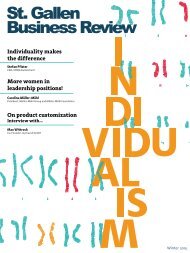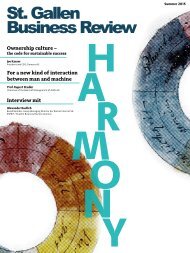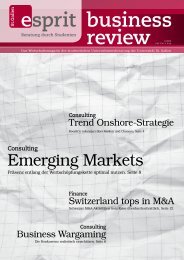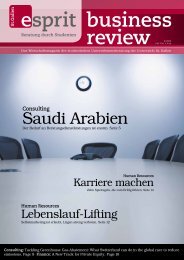Sicherheit und Risiko
St.Gallen Business Review Winter 2012
St.Gallen Business Review
Winter 2012
Erfolgreiche ePaper selbst erstellen
Machen Sie aus Ihren PDF Publikationen ein blätterbares Flipbook mit unserer einzigartigen Google optimierten e-Paper Software.
ESPRIT St.Gallen Business Review<br />
cal German superiority in any of these sectors, nor is it<br />
simply the unearned fruit of especially weak or dispirited<br />
competitors. Germany’s ongoing economic success,<br />
fraught with risks and instability though it may<br />
be, stems from a series of government-led efforts geared<br />
toward reducing the country’s high average labor<br />
costs and creating greater employment flexibility. These<br />
measures were implemented during the first half of<br />
the 2000 decade and subsequently allowed Germany<br />
to take unprecedented advantage of Europe’s common<br />
market – by consistently out-competing its neighbors<br />
(see Figure 1).<br />
Beginning in 2003, Chancellor Gerhard Schröder’s<br />
government instituted a series of “pro-growth” labor<br />
market and welfare state reforms known as Agenda<br />
2010, which curtailed unemployment and healthcare<br />
benefits, and reduced old-age pension levels (while<br />
raising the age of initial eligibility). It was a marked<br />
shift from the climate of high manufacturing wages<br />
and secure jobs, which had prevailed in Germany for<br />
decades. The result was the emergence of a sizeable<br />
low-wage sector, characterized by greater employment<br />
vulnerability and increasingly occupied by temporary,<br />
seasonal, and other kinds of flexible workers. As Figure<br />
2 shows, German labor costs, which used to be<br />
among the highest in Europe, fell significantly below<br />
the Eurozone’s average. Aro<strong>und</strong> the middle of the decade,<br />
German firms began to reap the benefits of their<br />
new low-wage workforce, which in combination with<br />
heavy capital investment and government subsidies<br />
for advanced production technologies, allowed the nation<br />
to become extremely competitive in high-valueadded<br />
exports. Given the favorable exchange rate that<br />
had been applied to the Deutsche Mark during the<br />
introduction of the Euro, these developments further<br />
enhanced Germany’s economic advantage relative to<br />
its neighbors.<br />
Yet in Europe’s common market, as in any market<br />
framework, there are winners and losers. In the<br />
European Union, the Greek people are perhaps the<br />
most clear-cut losers, despite the supposed benefits<br />
offered by EU membership. After joining the union<br />
in 1981, Greece became a major recipient of intra-<br />
EU transfer payments. The introduction of the Euro<br />
further enhanced the Greek government‘s fiscal capacity,<br />
allowing it to issue debt in a competitive currency<br />
on global financial markets. Greek leaders, however,<br />
did not spend this capital wisely – at least not in the<br />
eyes of global financial markets. Heavy investment in<br />
infrastructure upgrades and national modernization<br />
Trends in EU labor costs<br />
Source: OECD.Stat. Dataset: Unit Labour Costs - Annual Indicators. http://stats.oecd.org/ (accessed November 5, 2012).<br />
38<br />
Winter 2012


















